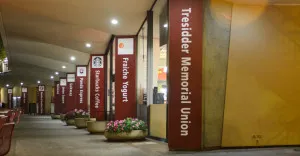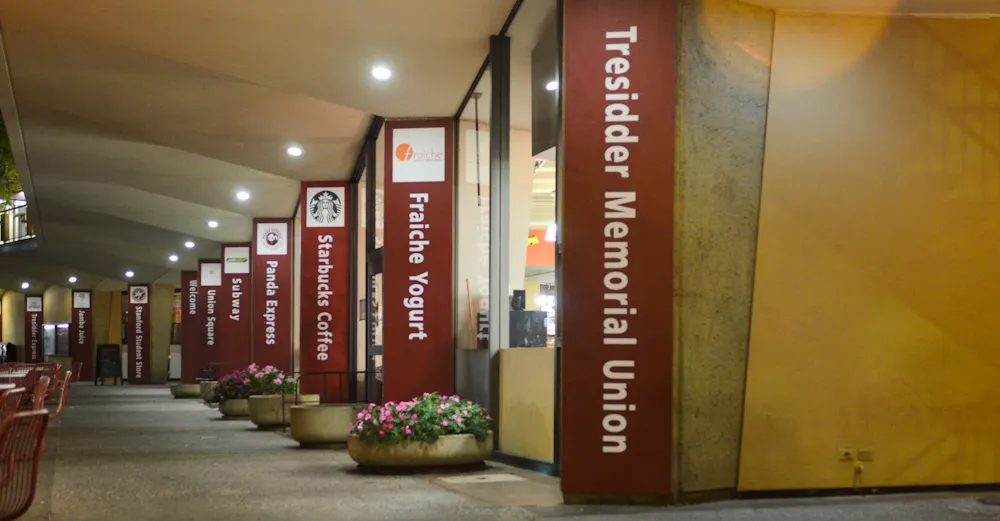
As Stanford commemorates the 50th anniversary of Tresidder Union this year, the University has begun re-examining the state of the student unions, questioning whether the spaces are still meeting the needs of Stanford undergraduates.
While Tresidder has taken on a more commercial role in recent years, focus groups held by the University have injected new momentum for the space to return to being a student union that is “all about students,” according to Jeanette Smith-Laws, director of operations and student unions.
“Part of the Tresidder 50th is to see where Tresidder will be years from now,” Smith-Laws said. “We are looking for creative ways to make use of the spaces there.”
Nested into a cluster of oak trees, Tresidder was initially designed with the students in mind and dedicated to Donald Tresidder, the fourth president of Stanford University, who was known for his commitment to students. The space hosted an open patio space scattered with wire mesh Eames-style chairs, a 14-lane bowling alley and a pool hall.
“When Tresidder Union was opened in 1962, it was ahead of its time,” Smith-Laws said. “We had air-conditioning, meeting rooms, retail spaces, [a] music listening room…The second floor was all open lounge spaces.”
She recalled seeing a diverse array of events in Tresidder, spanning from the telecast with famed CBS News President Fred Friendly to the wedding of a Stanford employee, Brenda Sepolen.
“If you can think of an event, we have done it here,” Smith-Laws said. “Before those other places were built, this was the place where people came.”
Eventually, those “other places” entered into the picture. Since Tresidder opened, the University has seen a multitude of new residential complexes and meeting centers budding across campus, making meeting spaces in Tresidder less essential.
Tresidder has also transformed over the years. The old tattered Pac Man machine in the arcade was replaced by a 24-inch plasma screen TV, and the space that housed the 14-lane, no-waiting bowling alley is now the fitness center, student store and part of Union Square.
According to Smith-Laws, some of these changes have been rejuvenating. This August, the University introduced Starbucks to Tresidder, making it the first full-service store built and operated by the coffee chain on a college campus anywhere in the country.
“‘It is breathing life into this space,” Smith-Laws said. “It has provided a social hang-out place that we didn’t have before.”
Meanwhile, new student enterprises have found their way into Tresidder as well. Among them is the Stanford Student Store, run by Stanford Student Enterprises, a student organization that provides hands-on business experience to student employees. According to Erica Yuen ’14, a junior working part-time in Student Store, Starbucks is also helping drive customers to other Tresidder stores.
Because of meeting room rentals and retail stores like Starbucks, Tresidder collects enough funds to sustain the operations of both itself and Old Union, according to Smith-Laws.
“I call Tresidder Union the workhorse,” Smith-Laws said about its role in generating revenue. “It really all goes back to students if you think about it, because it is how we stay open.”
Some students have expressed concerns about the commercialization of the student union. Doctoral candidate and Daily staffer Tom Taylor, M.S. ’04, said the University had finally “sold us out” in a Sept. op-ed decrying the new Starbucks chain. (“Taylor: Stanford selling out on students” Sept. 25, 2012).
“We are looking for things that can make us a better space,” Smith-Laws said. “We are seeking to let the students know about what spaces are available. We are thinking about making an outdoor movie screen. We have art that we are going to put on the outside walls.”
She also said that the University will be trying a pilot program during finals week that will keep the second-floor lobby of Tresidder open for 24 hours.
Tresidder may hardly resemble its original form but according to Howard Konad, who has worked at Stanford Hair for the past 28 years, the space hasn’t changed as much as it seems.
“I have been here since 1984,” Konad said. “And it has been the same because the students are the same.”
A previous version of this article stated that the CoHo replaced the bowling alley. In fact, the bowling alley and the CoHo existed simultaneously. The bowling alley was replaced by the fitness center area, student store and part of union square. The Daily regrets the error.
